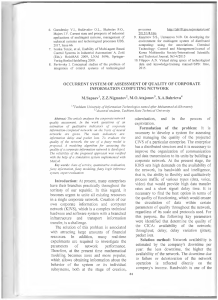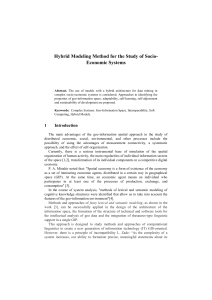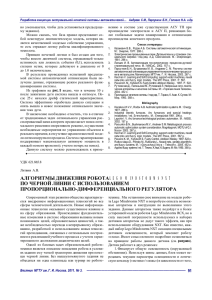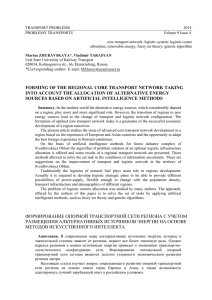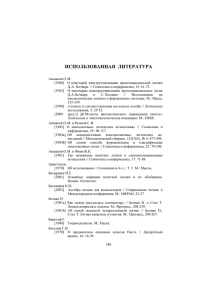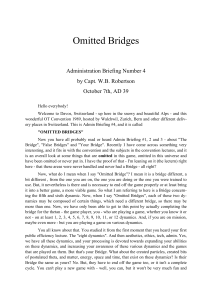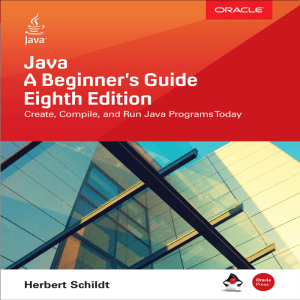8.3. Формы функции принадлежности лингвистических
реклама
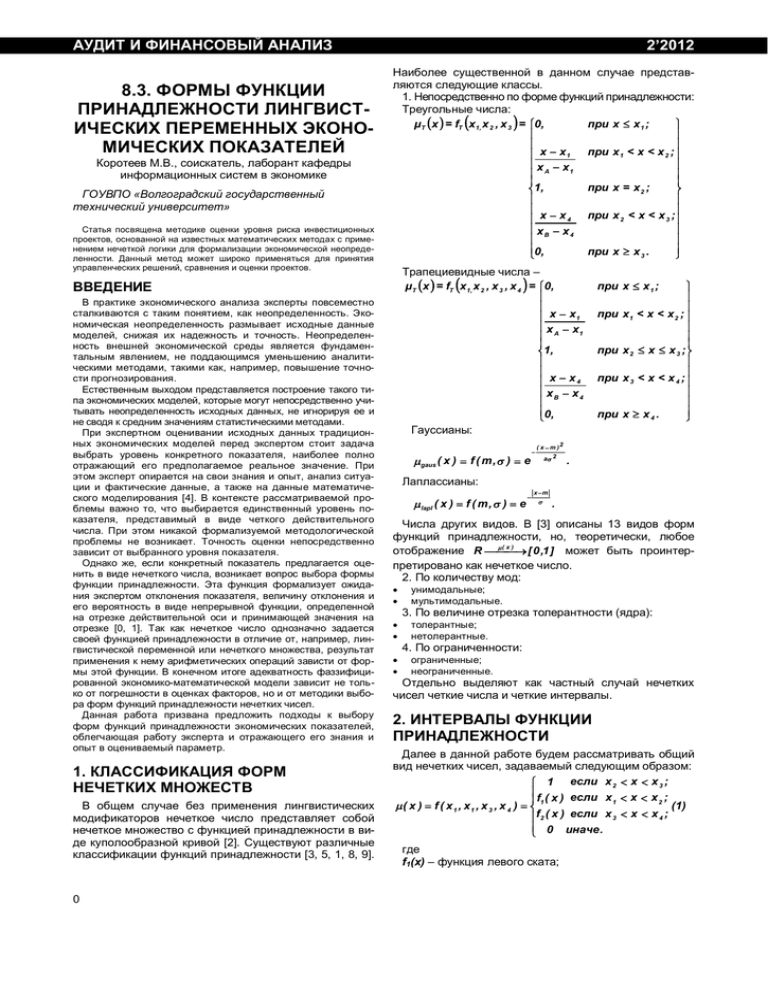
2’2012 . 8.3. 1. : ., : T x = fT x 1, x 2 , x 3 = 0, , « » , - . , . . , . , , , - , . - , , . , . gaus - , [4]. , (x) f ( m, ) 1, x = x2 ; x x4 xB x4 x2 < x < x3 ; 0, x x e f ( m, ) e . . x x1 x A x1 x1 < x < x 2 ; 1, x2 x x4 xB x4 x3 < x < x 4 ; 0, x ( x m )2 a 2 x3 ; x4. . - x . [3] , , [ 0 ,1 ] (x) R . , x1 ; x m lapl ( x ) . . x3 . : , , x1 < x < x 2 ; : - , x1 ; x x1 x A x1 – x = fT x 1, x 2 , x 3 , x 4 = 0, T , x 13 , . 2. : ; , . , 3. ( ): ; [0, 1]. , , - , . 4. : ; - . , . . . , 2. . , 1. (x) f ( x 1 , x1 , x 3 , x 4 ) - : 1 f1 ( x ) x2 x1 x x x3 ; x2 ; f2 ( x ) 0 x3 x x4 ; [2]. [3, 5, 1, 8, 9]. 0 f1(x) – ; . (1) . f2(x) – . . - . 1. : (1) x x1 (x) . , - x2 x2 , . . , x1 - , x2 . x . . - – . , - . , , / , . (x2 = x3). 2. , . x1 - , x x2 . . . - , , / . . 3. . , , . , , - . , - . . , - , , ( , .). , . 3. - - , . 1. . , .1 . f( x) 1, ( sup( ( x )) (1). , . , - , , 1 ). - , , . 4. - . . . , , - . 1 2’2012 . 2). , , circ=lambda a, b: lambda x: abs(1 – ((x – a) / abs(b – a))**2)**0,5. , - . : quad=lambda a, b: lambda x: 1 – ((x – a) / abs(b – – a))**2. [7] - , , . - , , , lin : (x) c x a f ( a, b,c , x ) b ; b (3) c 2 . 2. ( , ) quad (x) f ( a, b,c, x ) a– , 1 – (4) ) – ; b– (1), , , , . b b , ( . , ( , – x a ) – , - , , ( ; – ), , - – , . . , lin c>1 : ( x1 , x 2 ) f ( x , x1 , x 2 ) x x2 x1 , x1 (2) , c < 1, « - , , - » . c=0 . - , ; , - ( – ): lins = lambda a, b: lambda x: ((x – b) / (a – b)). , , [200, 350] , 500 , lins(350, 500). . . , : , . ( – ), . - , , 50 , : lins(200, 50). [3]: . 3. ( ) 2 c = , .3 - . , - , . 3. . . - – – . . - , , , . - . 5. 4. . - , : (x) . f ( x , x 1 , x 2 , x 3 , x 4 , c l , c r , fl , fr ) x2 x1 x3 1 fl ( x 2 , x 1 , c l , x ) f r ( x 3 , x 4 , cr , x ) x x x x3 ; x2 ; x4; 5. (5) 0,5- . 0 , . , . . - , . , , , . - . 0,5. . , , . 4. , : c lin , - , . . , , x = lin x a b b log c b 0.5 a b , . , : . 4). - . quad 1. – x =1 - , . x a (6), b b 2 log 1 : , , . x1 x4. - , , . - (8) ; . .5 . , - 2 0.5 0,5- . 2. c b a b - x2 - x3. (7) ; (5) - ( (6) a b - , x b = 0,5 ; x = a b c = log x b 0.5 ; , . - . 5 : 1,0, 0,0 - 0,5. 3 2’2012 2 2 x a ; ln0,5 = (10) 2 x gauss a ln0,5 2 c a x =e ; , (11) [3]: : x lapl x =e a ln0,5 c a (12) ; : cauc 1 x = 1+ . 5. . x gauss x =e a c2 : , 2 ; (13) : log x = ln3 ; a a 2 2 1+ e (9) x c a a 2 . (14) .6 : . . 6. , (e) 4 x c , (f) . (a) , (g) , (b) , (h) , (c) , (j) , (d) - . . . , . : , , . ., . , , , . - » - 8.3. MEMBERSHIP FUNCTIONS OF THE ECONOMIC FACTORS'S LINGUISTIC VARIABLES - M.V. Koroteev, Department of Information Systems in Economics Lab. Assistant . , . ( ): : Volgograd state technical university (VSTU), Volgograd, Russia (7); (8); : This article is viewing new method of estimating the risk level of investment projects based on a well-known mathematical approaches in addition with fuzzy logic in order to formalize economic uncertainty. This method can be widely used in making manager's decision, projects ranking and estimation. (11); (12); ( , « - . ., (13); (14). ) 1. Collan M., Fuller R., Mezei J. A fuzzy pay-off method for real option variation // Journal of applied mathematics and decision sciences. 2009. Vol. 2009. 2. Dubois D., Prade H. Fuzzy numbers: an overview // Analysis of fuzzy information. 1987. Vol. 1. Pp. 3-39. 3. Mitaim S., Kosko B. The shape of fuzzy sets in adaptive function approximation // IEEE Transactions on fuzzy systems. 2001. Vol. 9. 4. 4. Sugeno M., Yasukawa T. A fuzzy-logic-based approach to qualitative modeling // IEEE Transactions on fuzzy systems. 1993. Vol. 1. 1. 5. Rutkovskaya D., Pilinsky M., Rutkovsky M. Neural networks, genetic algorithms and fuzzy systems: Translator: I.D. Rudinsky. Telecom, 2004. 452 p. 6. Weisstein E.W. Wigner's semicircle law. From MathWorld-A Wolfram Web Resource. http://mathworld.wolfram.com/ WignersSemicircleLaw.html 7. Zadeh L.A. The concept of a linguistic variable and its application to approximate reasoning // Information sciences. 1975. Vol. 8. Pp. 199-249. 8. Zadeh L.A. Fuzzy sets // Information and control. 1965. Vol. 8. Pp. 338-353. 9. Zaychenko Y.P., Zayec I.O., Kamocky O.V., Pavluk O.V. Study of different types of membership of function parameters of fuzzy forecasting models in fuzzy arguments group method. ; ; ; ; ; ; Literature 1. M. Sugeno, T. Yasukawa. A fuzzy-logic-based approach to qualitative modeling. // IEEE Transactions on fuzzy systems. Vol. 1, 1. 1993. 2. Dubois, D. and Prade, H., «Fuzzy Numbers: An Overview», // Analysis of Fuzzy Information 1:3-39, CRCPress, BocaRaton, 1987. 3. Rutkovskaya D., Pilinsky M., Rutkovsky M. Neural networks, genetic algorithms and fuzzy systems: Translator: I.D. Rudinsky. Telecom, 2004. 452 p ISBN 5-93517-103-1. 4. S. Mitaim, B. Kosko. The shape of fuzzy sets in adaptive function approximation. // IEEE Transactions on fuzzy systems. Vol. 9, 4. 2001. 5. Weisstein, Eric W. «Wigner's Semicircle Law». From MathWorldA Wolfram Web Resource. http://mathworld.wolfram.com/ WignersSemicircleLaw.html 6. L.A. Zadeh. The concept of a linguistic variable and its application to approximate reasoning. // Information sciences 8, pp 199-249. 1975. 7. Y.P. Zaychenko, I.O. Zayec, O.V. Kamocky, O.V. Pavluk. Study of different types of membership of function parameters of fuzzy forecasting models in fuzzy arguments group method. 8. L.A. Zadeh. Fuzzy sets. // Information and control, 8(3), pp. 338-353. 1965. 9. M. Collan, R. Fuller, J. Mezei. A fuzzy pay-off method for real option variation. // Journal of applied mathematics and decision sciences, Volume 2009. Keywords ; ; . ; Investment project; uncertainty; risk; fuzzy logic; membership function; fuzzy arithmetic; mathematical modeling; net present value; internal rate of return; fuzzy relation. . , . , - . . : , 5
